How to Clean Artificial Flowers: 5 Easy Methods
How to clean artificial flowers is not hard. Dust kills color, photos look dull, and guests notice. U get fast steps that any team can run daily.
Playbook: dry dust first, then mild soap and water, use vinegar or a plant-safe spray for film, blow cool air for folds, and prevent dust with simple SOPs. Read more on materials in our older guide How to Style Artificial Flowers (Retail Guide) and UV claims in UV Spray for Outdoor Artificial Plants.
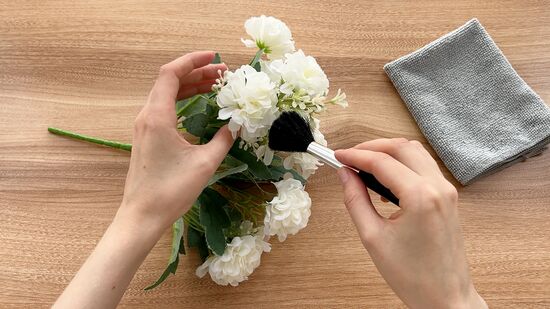
Use: SOP cover image for retail, hotel, and event teams to standardize cleaning.
U want quick wins, safe products, and a routine that scales across stores, venues, and warehouses. This guide adds short client stories, so U can see time saved, returns reduced, and brand photos improved. For sourcing pieces that tolerate wet care, browse our catalog and backgrounder Faux Greenery Meaning & Use Cases.
How to Clean Artificial Flowers — Why It Matters
Dust hides color, texture, and shape. Photos flatten. Touch tests fail. Returns start. Teams then scramble before events and lose time.
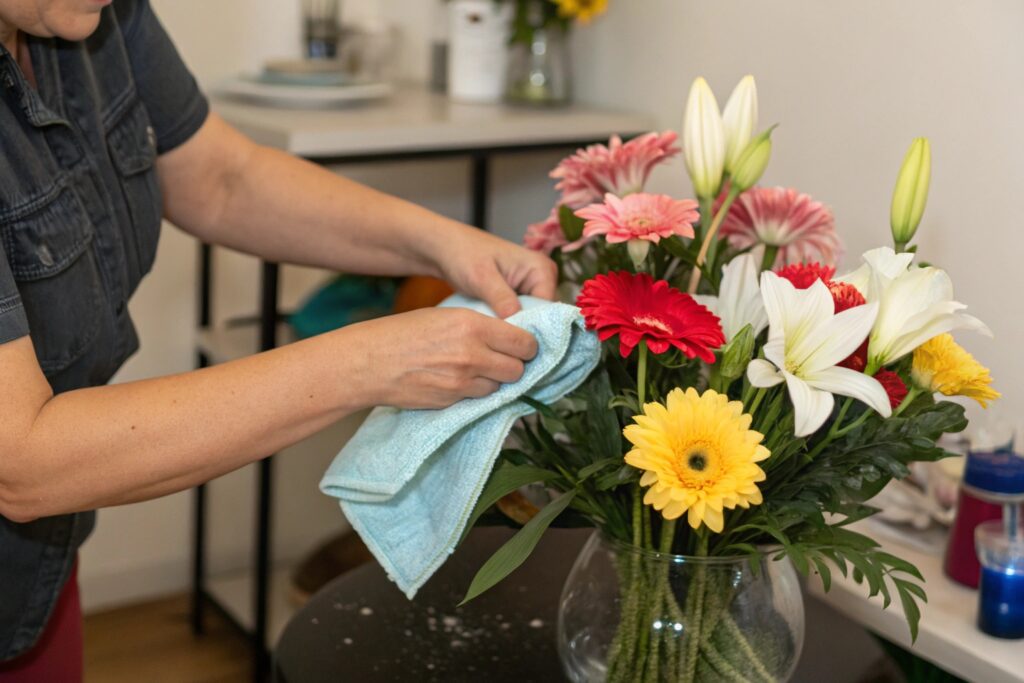
Use: Staff onboarding deck to explain how cleanliness drives sales and guest scores.
What “clean” changes for U
How to clean artificial flowers affects three things: (1) color accuracy in-store and online; (2) surface integrity on silk-touch petals and PE leaves; (3) guest comfort in cafés, lobbies, and showrooms. A simple 90-second dust pass on a box-store end-cap lifted engagement because the display looked new—shoppers touched and bought. If U manage outdoor décor too, cross-check field notes in Best Fake Plants for Outdoors (2025).
Client story
A Dubai hotel asked why lobby florals looked flat in photos. U move planters 60 cm off a vent, set a 2-minute daily dust route at 10:00, and swap one glossy vase for satin to hide lint. Photos improved in three days, and housekeeping finished faster.
Method 1 — Dry Dusting with Cloth or Brush
Teams skip dusting because it seems slow. It’s fast when U standardize tools and motions.
Use a dry microfiber cloth and a soft cosmetic brush. Work top to bottom, outside to inside. Support petals with your fingers. Keep strokes light to avoid bent wires.
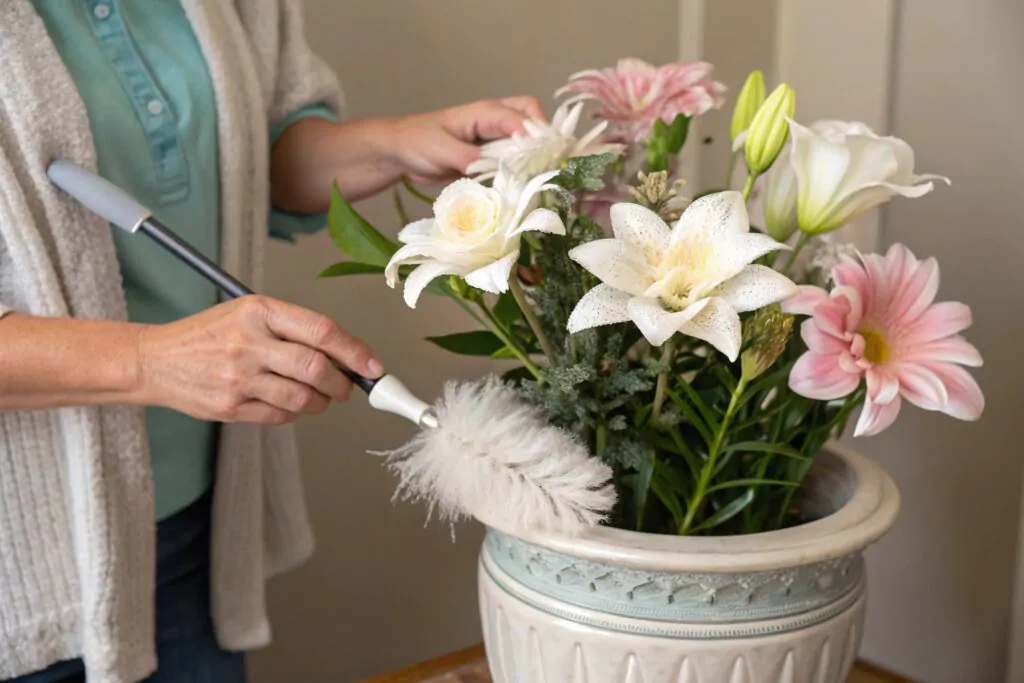
Use: Daily 90-second routine for storefront bouquets and reception desks.
Step-by-step staff can copy
- Stage 3 tools: wide microfiber cloth (large leaves), soft makeup brush (folds), fine artist brush (creases).
- Start with the tallest stems so dust falls onto what U clean next.
- Brace each petal from behind; tap or sweep lightly.
- Use longer strokes on PE/PU leaves; short taps on silk-touch petals to reduce static.
- Store a clean cloth in a zipper bag so lint doesn’t travel site to site.
Client story: A homeware chain in Queensland had dull tops on aisle displays. With a 50 mm brush and braced petals, the pass took 90 seconds per bouquet. End-cap sales rose because LEDs read the color again.
Method 2 — Mild Soap & Water (Spot Wipe)
Water scares people. It’s safe when U test and control it.
Mix lukewarm water with one drop of mild dish soap per liter. Spot test under a petal. Wipe—don’t soak. Rinse with a damp cloth. Air-dry in shade, not sun.
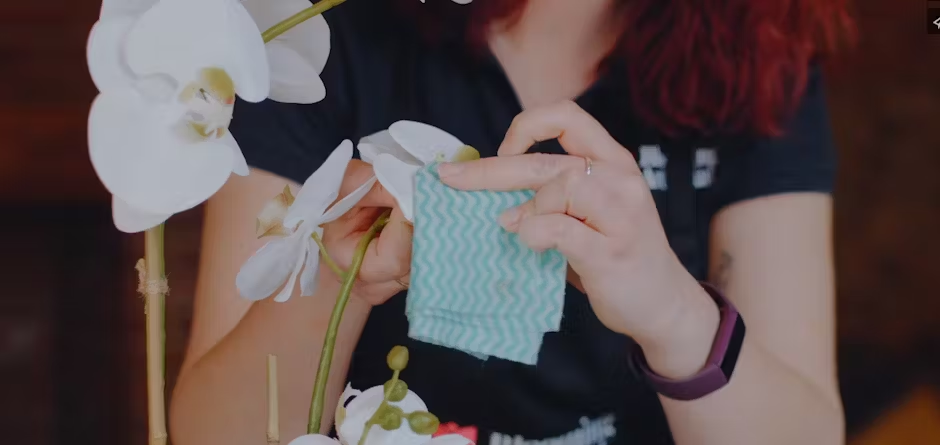
Watch-outs by material
- PE/PU leaves on molded ribs tolerate a damp wipe well.
- Fabric petals with heat-cut edges need lighter pressure.
- Paper or preserved pieces dislike water—keep dry methods only.
- Use a white tissue test for dye transfer before committing.
- Fold the cloth in quarters; wipe in vein direction; avoid hubs where petals meet the calyx.
Client story: A wedding rental client in Texas scrubbed a coffee mark and frayed fibers. One-direction passes with diluted soap plus a rinse cloth cleared the stain in three minutes. Re-rent quality improved.
Method 3 — Vinegar or Plant-Safe Spray
Kitchen mist, smoke film, or hard-water marks need more bite. Vinegar helps. Plant sprays can help too.
Use a 1:1 white vinegar–water mix. Mist the cloth, not the flower. Wipe and dry. For any commercial spray, test a hidden petal first. Avoid ammonia or alcohol on soft-touch finishes.
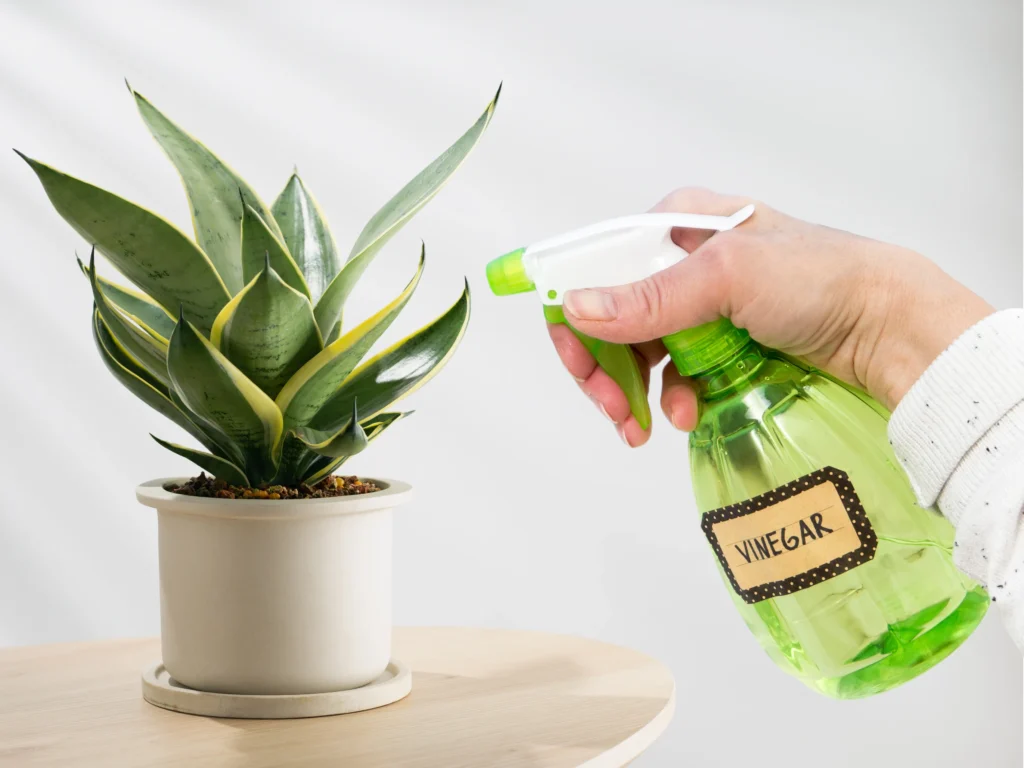
When to choose vinegar vs. spray
Vinegar breaks grease without strong scent. Never spray hubs or open seams. Spritz the cloth and roll through the mark. On silk-touch petals, dilute to 1:2 to reduce bite. Anti-static sprays can help dust stay off longer—always tissue-test for color lift.
Client story: A café group in Melbourne fought a thin grease film on hanging ivy. A 1:1 vinegar pass with a microfiber pad (90 seconds per hanger, twice a week) cleared the film in a week; photos looked sharp again.
Method 4 — Cool Air (Hairdryer) or Compressed Air
Air moves dust out of folds in seconds—but it can blow parts loose if U push too hard.
Use a hairdryer on cool, low speed from 30–40 cm, or use compressed air in short bursts. Hold stems. Sweep across petals, not into them. Work outdoors or in a service area.
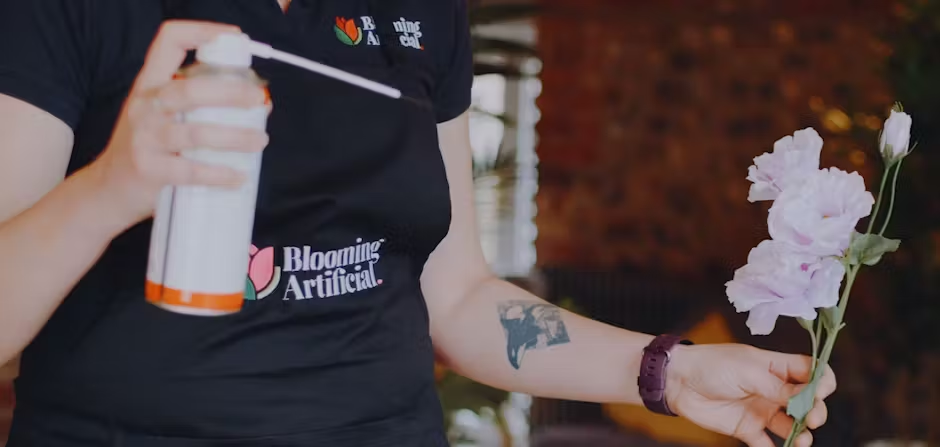
Keep it safe
- Coolest dryer setting; aim across the surface.
- On greenery walls, sweep left-to-right lines from the top.
- Avoid flocked parts (fibers can lift).
- Finish with a lightly damp cloth on the front face to ground static.
Client story: A mall in Toronto ran a peony chandelier over seating. A cordless dryer on cool plus a pole brush twice weekly cut dust halos in social photos and saved ladder time.
Method 5 — Preventive Maintenance
The best clean is the one U don’t need. Small moves block dust and save labor.
Place away from vents, shield during installs, add a weekly light pass, and store with covers. Use anti-static wipes on final passes. Track minutes with a one-page checklist.
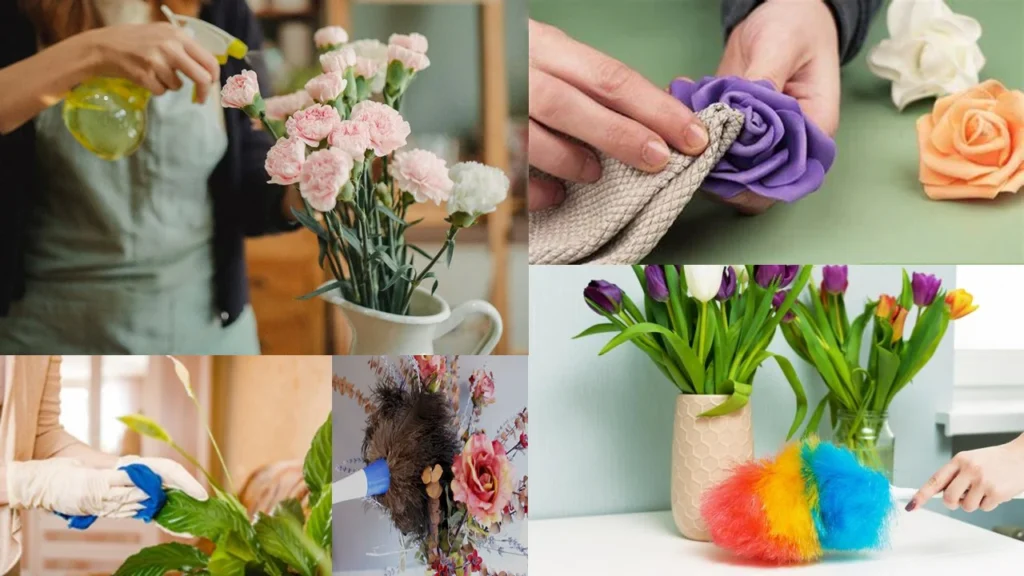
Before dust forms
- Lift arrangements 5–10 cm off shelf backs so air can move.
- Map high-flow paths and assign a fast route.
- Cover displays during overnight fit-outs to block drywall dust.
- Label boxes by set and month; add silica gel in coastal sites.
- Finish PE leaves with a light anti-static wipe so dust clings less.
Client story: An events agency in London ran back-to-back weekends. A five-step reset (cool air, brush, wipe hubs, quick vinegar on glass, anti-static finish) took two people eight minutes per table. Day-two photos looked like day one.
My Take for High-Volume Buyers — Scale Your SOP
Multi-site teams need speed, safety, and the same look everywhere.
Standardize two daily tools and one weekly wet method. Train a three-step motion. Use photos to define “done.” Buy materials that tolerate these steps and demand written specs.
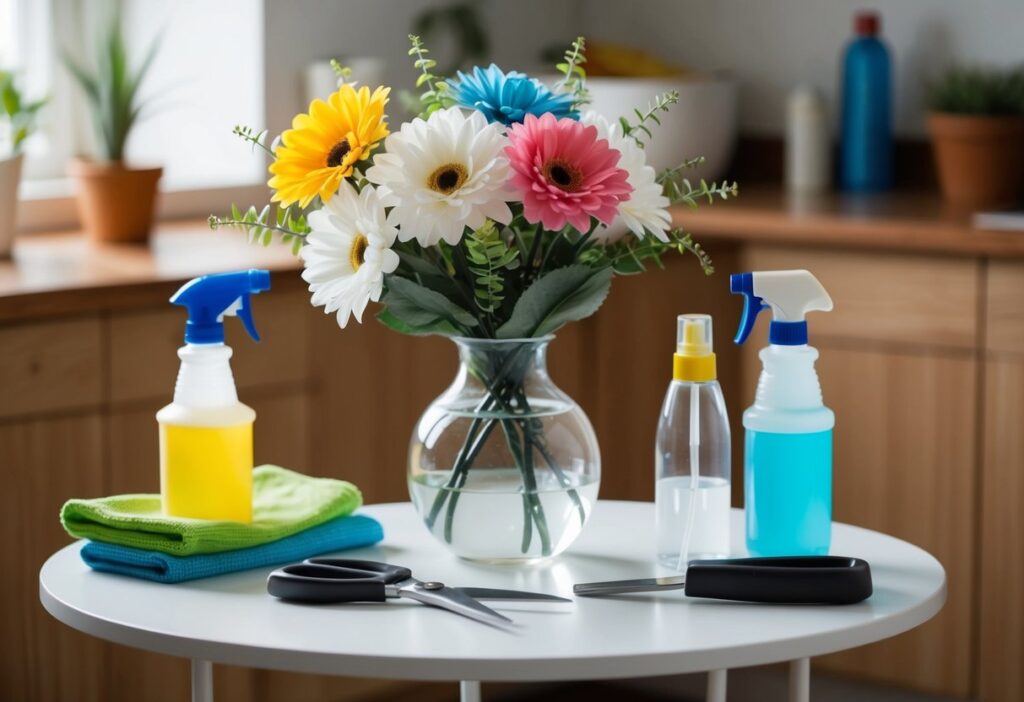
How to set the SOP
- Daily: one soft brush + one microfiber cloth.
- Weekly: mild-soap wipe with test rules.
- Keep vinegar for kitchen/smoke zones only.
- Motion: brush top arc → dust front face → wipe high-touch hubs.
- Time caps: 2 min per large planter; 90 s per bouquet.
- Photo gallery of “clean vs. not clean” for day-one training.
For purchasing alignment and long-term partnerships, review our About/Contact and Catalog pages.
Conclusion
How to clean artificial flowers is simple: dry dust, controlled wet wipes, smart sprays, cool air, and prevention. U get bright displays, longer life, and fewer returns.
FAQ
- 1) How do U clean artificial flowers at home?
- Brush dust first. Wipe stains with a damp microfiber and a drop of mild soap. Test on a hidden petal. Dry in shade. See setup tips in How to Style Artificial Flowers.
- 2) Can artificial flowers be washed with water?
- Yes for PE/PU leaves if U don’t soak hubs. Wipe with a damp cloth, rinse, and air-dry. Avoid paper and preserved parts. For outdoor picks that tolerate wet care, start with Best Fake Plants for Outdoors.
- 3) How often should faux flowers be cleaned?
- Weekly in busy sites, biweekly in quiet rooms. Run a quick reset before photos or events. Align your weekly pass with the SOP above.
- 4) What’s the best way to remove dust from silk flowers?
- Use a soft cosmetic brush. Support each petal with your fingers. Finish with a cool-air pass from 30–40 cm.
- 5) Do cleaning methods affect color or material quality?
- Harsh solvents and heat do. Mild soap, water, and vinegar are safe when tested and applied with a cloth—never spray directly.
- 6) Can U use compressed air on faux flowers?
- Yes—short, cool bursts; hold stems; avoid flocked parts. Follow workplace safety rules for compressed-air use.
- 7) How do U fix greasy film near kitchens?
- Use a 1:1 water–vinegar mix on a cloth. Wipe and dry. Add an anti-static finish on PE leaves to slow new dust.
- 8) What tools should every site store?
- One microfiber cloth, one soft brush, a small spray bottle, mild soap, and a cordless dryer on cool.
- 9) How do U prevent dust from building up again?
- Move arrangements off vents, add weekly passes, store with covers, and use anti-static wipes on final passes.
- 10) Will sun exposure change how U clean?
- Yes. Avoid hot drying. Keep wet care in shade. If edges get brittle, switch back to dry dusting only.
Next Steps — Choose Your Path
Get Your Sample
Contact Our B2B Team
Quick Reference — Buyer Questions U Might Ask
- Need to know how to clean artificial flowers in retail displays? Run a daily dry-dust pass before doors open.
- Wondering how to clean artificial flowers for hotel lobbies? Pair microfiber with a weekly spot wipe in shade.
- Planning photos and asking how to clean artificial flowers for e-commerce shoots? Do a cool-air sweep to reset texture.
- Ops teams asking how to clean artificial flowers before shipment? Use a lint-free cloth and avoid soaking hubs.
- Rental managers asking how to clean artificial flowers on returns? One-direction soap wipes prevent fray.
- Café crews asking how to clean artificial flowers with grease film? Use a 1:1 vinegar–water cloth wipe.
- Landscape buyers asking how to clean artificial flowers outdoors? Stick to dry methods and UV-safe parts.
- Designers asking how to clean artificial flowers with silk-touch petals? Tap, don’t drag, with a soft brush.
- Warehouse teams asking how to clean artificial flowers with PE/PU foliage? Long strokes with microfiber work best.
- Spec writers asking how to clean artificial flowers with preserved/paper blends? Avoid water; dry dust only.
- New staff asking how to clean artificial flowers consistently? Train a 3-step motion and photo “done” standard.
Pro Tips — Make It Stick Across Sites
- Franchise openings: document how to clean artificial flowers in your opening/closing checklist so every store hits the same standard.
- Photo prep: outline how to clean artificial flowers before each shoot (cool-air sweep → brush → quick spot wipe) to cut retouch time.
- Warehouse QC: standardize how to clean artificial flowers at “pre-pack” so cartons arrive camera-ready and returns drop.
- Audit binder: include a one-pager on how to clean artificial flowers with materials do/don’ts (PE/PU vs silk-touch vs preserved).
